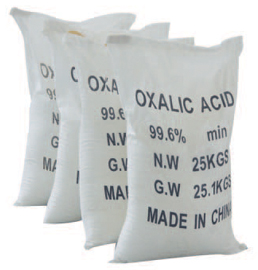
Invasive approach: inhalation.
Respiratory protection: generally no special protection is required and wear a respirator if necessary.
Eye protection: safety mask can be used.
Protective clothing: wear anti-corrosion work clothes.
Hand protection: rubber gloves.
Skin contact: rinse immediately with water for at least 15 minutes. If you have burns, seek medical treatment.
Eye contact: immediately lift your eyelids, rinse with flowing water or saline for at least 15 minutes, or rinse with 3% boric acid solution.
Inhalation: from site to fresh air. Artificial respiration when necessary.
Ingestion: the person who misserves drinks milk or egg white. Seek medical attention immediately.
Extinguishing method: fog water and sand.
Others: after work, shower. Pay attention to personal hygiene.
Leak emergency treatment: isolate the contaminated area and set warning signs around. Emergency workers wear gas masks and chemical protective clothing. Do not contact the leak directly. Avoid dust and use clean shovels to be collected in a clean, clean and clean container for waste disposal sites. You can also flush with a large amount of water and then dilute the lotion into the waste water system. If a large amount of leakage is collected, collection or disposal is discarded.
Wastewater treatment method: the wastewater that causes sulfide pollution is mainly alkaline wastewater, which can be neutralized and treated. In the neutralization phase, the pH decreases partially the hydrogen sulfide dissipation in the atmosphere, while the heat generated by neutralization reaction also increases the release rate of hydrogen sulfide. Hydrogen sulphide is released in large quantities in the air, which can contaminate the air and cause disturbance to the people. It is also an effective method to eliminate sulfide pollution by means of chlorination, but it requires a large amount of chlorine and high cost. In addition, in adding iron sulfide pollution of waste water or non-toxic iron salts (such as ferric sulfate and ferric chloride, etc.), after 2 hours after aeration, the active iron hydroxide, but to remove sulfide in the form of iron sulfide precipitation. It can also be treated with activated sludge process by neutralizing the serious wastewater from sulfide. [6]
Sulfur compounds in the water include solubility H2S, HS -, S2- and soluble sulphides, acid soluble metal sulphides and non - ionized inorganic and organic sulphides in suspended substances. The sulphide is mostly black and pungent, mainly because H2S gas is constantly released from the water. In the air, the H2S of 8 mu g/m3 can be sensitive to smell, and the threshold value of H2S in water is 0.035 mu g/L. The sulfide in the water is easy to hydrolyze, which is released into the air in the form of H2S. After being absorbed by a large number of people, nausea and vomiting can be caused immediately, even breathing difficulties and asphyxiation. If the air reaches 15 ~ 30mg/m3, it can cause inflammation of the eye membrane and damage the optic nerve. Dissipation in H2S has long been people breathe in the air, but with the human body cytochrome oxidase and disulfide bond of human proteins, amino acids (- S - S -) role, affect the oxidation process of cells, causing cell hypoxia, endanger human life. Long-term consumption of high sulfide water can lead to dull taste, loss of appetite, weight loss, poor hair growth, and severe failure and death.